Certification
Newsletter Archive
Below you will find an archive of Certification newsletters.
If you have questions or topic suggestions for future newsletters, please contact AISC Certification at certification@aisc.org or 312.670.7520. Thank you and happy reading!
Newsletter 2019-Q4
New, Simplified Fee Schedules
With the release of Scheduling 2.0 and Bulletin 2019-05, we are streamlining our certification processes to make things more straightforward for you. The next step is to make our certification fee schedules as simple as possible. But what you really want to know is whether we’re raising your rates. The answer is both no and maybe.
The No. The amount you pay over your three-year certification cycle will NOT change. We are simply averaging the amount you have previously paid for the full audit year with the amounts you have paid for the two years of renewal audits.
The Maybe. You’ll pay for the number of months you’ll be certified during the transition to Scheduling 2.0. You’ll probably move to a different certificate expiration month--it could be that your new certification expiration date is earlier than your current expiration month, or later. Either way, your fee will be prorated accordingly. This will be a one-time change, after which your annual fee will remain constant. For more information, please see Bulletin 2019-05. We’ve also linked to the updated fee schedules below:
And remember: We’re always on hand to help you with any questions. Give us a call at 312.670.7520 or send an email to certification@aisc.org.
2020 Inspection Conference
What are you doing in January 2020? Flying to Houston, right? That’s where the American Institute of Steel Construction (AISC), American Welding Society (AWS), The American Society for Nondestructive Testing (ASNT), and NACE International (The Corrosion Society) are joining forces to host our first structural steel inspection conference January 21-23.
Each association will have a tailored track, so you’ll be able to focus on structural steel construction, welding inspection, nondestructive testing, or corrosion engineering. Take a look at the technical sessions and see what you can learn about new technology and resources to improve the quality of your documents, visual inspections, procedures, and testing processes. For more information, visit 2020 Inspection Conference. We hope to see you there!
New Mock Exercises for you!
Sometimes, you may not have work in the shop or field, so we have created several new mock exercises for these situations. Below is a list of our current mock exercises.
- Mock Exercise Instructions for Fabricators of Steel Buildings
- Mock Exercise Instructions for Fabricators of Simple Bridges
- Mock Exercise Instructions for Fabricators of Intermediate Bridges
- Mock Exercise Instructions for Erector Seismic Endorsement
- Mock Exercise Instructions for Erector Metal Deck Installation Endorsement
For Advanced Bridge, Hydraulic, and Erector Certifications, along with the Bridge Erector Endorsement - you must have a demonstration of work/capability for the site audit. There are no mock exercises for these certifications and endorsement.
Newsletter 2019-Q3
Looking Forward to 2020: Welcome to Certification Scheduling 2.0!
Have you wished your annual audit would be at the same time every year? Haven’t you wished there wasn’t a rescheduling fee? Great news: AISC Certification is launching a new scheduling program that’s designed to make your life easier! The Scheduling 2.0 reorganization will provide more predictable audit dates, reduce the number of rescheduled audits, and keep program fees as low as possible. Read all about it in Bulletin 2019-05.
Standard for Certification Programs (AISC 207) Is Available for Public Review
AISC Standard for Certification Programs (AISC 207) is now available for public review until October 7, 2019. This document is an update to AISC 207-16 and adds requirements for hydraulic metal structures.
The standard is available for download on the AISC website at aisc.org/publicreview along with the review form. Please submit comments to Margaret Matthew (matthew@aisc.org) using this online form by October 7, 2019, for consideration. Copies are also available (for a $35 nominal charge) by contacting Rachel Jordan at 312.670.5411 or by e-mailing jordan@aisc.org.
Need to Reschedule Your Audit?
AISC Certification has listened to your feedback, and we are revising our audit rescheduling policy. You may reschedule your audit for no additional fee if you submit an approved rescheduling request within two weeks of the date you receive your audit invoice. Read Bulletin 2019-06 to learn more about this updated policy.
Erector Rescheduling and Jobsite Availability
We’ve just released Bulletin 2019-06.1 to provide clarity for erectors about jobsite availability. You must have an active jobsite at the time of the renewal audit, but what happens if you don’t? The Bulletin goes into those details and the options you have to maintain your current certification.
Newsletter 2019-Q2.1
Lights, Camera, New Governing Requirements!
There was a lot of material in Bulletins 2019-02 (for fabricators) and 2019-03 (for erectors), so we’ve made our first on-demand video to talk you through each document. This is important—the changes to the updated Governing Requirements for Certification Programs that we discuss in the video have a big impact on your upcoming audits and program participation and went into effect on June 1.
To help you keep track of all the new updates and changes, we have created the Governing Requirements Transition webpage with the updated Governing Requirements, a timeline, and additional resources.
Getting to Know You...
It’s crucial that we have the most current and correct information about your company so we can work with you effectively and help potential customers find you. We’ve started to list your company’s contacts on your annual invoice. You’ll see your Principal Officer, Certification, Accounts Payable, and Marketing contacts listed.
Here’s how we use that information:
The first three contacts listed (Principal, Certification, and Accounts Payable) will receive audit date and invoice notifications. Your Marketing contact, meanwhile, is listed on the AISC website—this is the name potential customers will find when they search for a certified participant through our website.
If you would like to change a contact (or your company name, ownership, website, location, or number of employees), you need to complete theCompany Profile Form.
The Governing Requirements for Certification Programs document provides additional information in PR 1.11 and 4.9, which read:
PR1.11: AISC relies on email to communicate with Applicants and Participants. Any changes to contact information MUST be provided to AISC. See PR4.9 concerning Company Profile. It is the Participant/Applicant’s responsibility to ensure communications are being received.
PR 4.9: Company Profile includes company information and contact information. Refer to PR1.11. Failure to provide timely notification of changes to the Company Profile may result in a canceled or incomplete site audit or suspension of certification. Changes in ownership, location, and company name may require additional audits. Therefore, the Participant is required, within 30 days of the change, to complete the Company Profile Form on the AISC website to inform AISC of changes to any of the following:
Facility: Company name, physical address of facility, mailing address, and ownership
Contacts: The names, telephone, and email of the following designated individuals:
- Principal Officer
- Certification Contact or Management Representative (may be the same person)
- Accounts Payable
- Marketing Representative
While positions identified above may be combined, a minimum of TWO unique email addresses for two DIFFERENT employees is required to ensure proper communication. The Participant’s continued certification is at risk if proper email addresses are not provided.
Big news: We’ve Created a Conference Just for You!
What are you doing April 22-24? You’ll want to book a trip to Atlanta! We’re debuting the first-ever Structural Steel Quality Conference at NASCC: The Steel Conference 2020. Industry experts will share the latest on both the principles of quality management and what you can do every day to improve your operations in more than 25 sessions designed specifically for our certified participants. Stay tuned for more information about the inaugural Structural Steel Quality Conference!
Get the Best of NASCC: The Steel Conference 2019
We hope you were able to join us in St. Louis for NASCC: The Steel Conference. If you couldn’t make it—or if you did, but want a refresher on the great things you learned there—you can now experience the Quality Track sessions on our website, free of charge!
This year, our attendees had a blast while acting out a live management review. Sessions on paint certification requirements and how calibration can streamline shop or job site processes also earned raves. You can catch up on these sessions and more online:
- Q1 - AISC Certification Forum
- Q2 - What Do AISC Certification Complaints and Appeals Policies Mean to Specifiers and Participants?
- Q3 - Let's Set that Goal!
- Q4 - Teamwork: No One in this Room is Smarter than All of Us
- Q5 - Areas of Concern and Corrective Action Requests: Streamlining the Process and Talking About the Root Cause
- Q6 - What Does “Management Review” Really Mean?
- Q7 - I Have a Quality Manual and Procedures – Now What?
- Q8 - The New Certification Standard: Update for Erectors
- Q9 - Steel Erectors Panel Discussion on Quality Control
- Q10 - Let's Get Down to the Nuts & Bolts (and Welding Electrodes): All About Jobsite Storage
- Q11 - The Paint Certification Primer
- Q12 - The Real Secret of Calibration
Newsletter 2019-Q2
Newsletter Introduction: What is happening on June 1, 2019?
Welcome to the Second Quarter AISC Certification Newsletter of 2019! Our newsletters are designed to provide you with news and information on how to get the most value from your Certification investment.
This issue includes information about:
- What is happening on June 1, 2019, that you need to know about?
- Bulletin 2019-02 (Critical AISC Certification Changes for Fabricators)
- Bulletin 2019-03 (Critical AISC Certification Changes for Erectors)
- Do you perform work in New York City? Then read Bulletin 2019-04 (Special Agency Audit Program).
If you have any questions, please contact us at certification@aisc.org or 312.670.7520.
Governing Requirements Transition
Beginning June 1, 2019, certified companies will follow the updated Governing Requirements for Certification Programs. The updated requirements reference the Standard for Steel Fabrication and Erection, and Manufacturing of Metal Components (AISC 207-16).
AISC Certification has released two Bulletins covering the changes to the AISC Certification program documentation and enforcement procedures:
- Bulletin 2019-02 (Critical AISC Certification Changes for Fabricators)
- Bulletin 2019-03 (Critical AISC Certification Changes for Erectors)
To help you with the transition, we have created the Governing Requirements Transition webpage with the updated Governing Requirements, a timeline, and additional resources.
Special Agency Audit Program for New York City
Do you perform work in New York City? If you are approved by their Office of Technical Certification and Research (OTCR) and listed on their Approved Fabricator List, you may perform inspections that have traditionally been performed by outside, third-party special inspectors. Transferring the special inspections will save a lot of money for the owners you work with, which will distinguish you from the competition. Find out more by reading Bulletin 2019-04 (Special Agency Audit Program).
Newsletter 2019-Q1
Newsletter Introduction: Welcome to 2019!
Welcome to the 2019 First Quarter AISC Certification Newsletter! Our newsletters are designed to provide you with news and information on how to get the most value from your Certification investment.
This issue includes information about:
- Quality sessions at the upcoming NASCC: The Steel Conference in St. Louis, April 3-5, 2019
- New certification logos
- The latest certification bulletin (Bulletin 2019-01: Erector Audit Confirmations)
- Our recently created Certification Resources site
- New certificate design
If you have any questions, please contact us at certification@aisc.org or 312.670.7520.
NASCC: The Steel Conference and the Quality Track
All signs point to NASCC: The Steel Conference where a special quality track will focus on topics of interest to fabricators and erectors. See all the quality sessions here. Meet us in St. Louis to learn more about quality management systems and AISC Certification. Visit aisc.org/NASCC to register today!
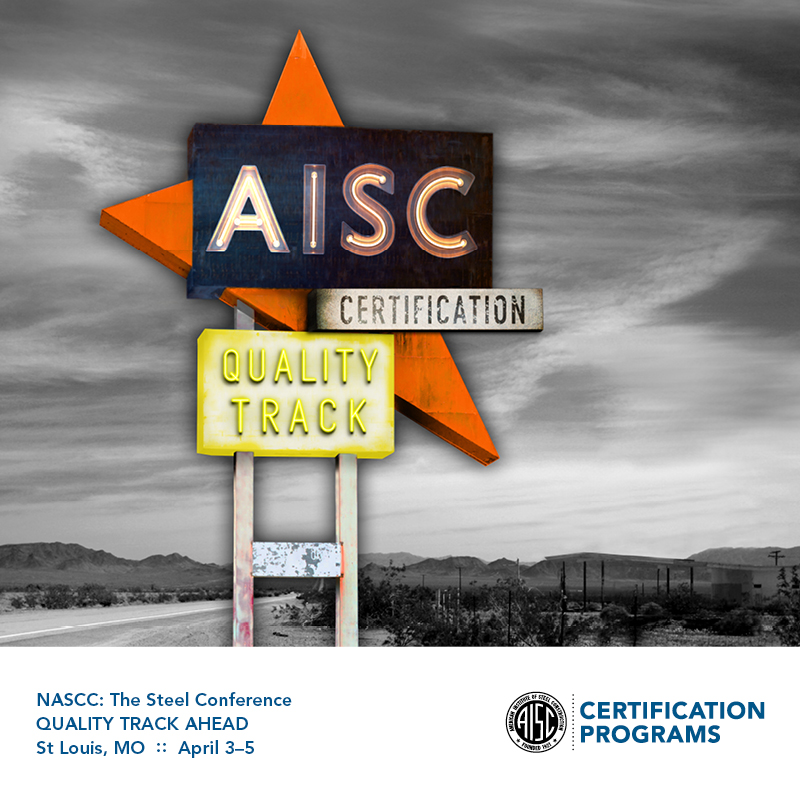
New Certification Logos
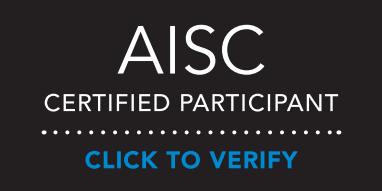
AISC released new certification logos, which include both static logos for print and a new certification smart logo for participant's websites. In February, we emailed your company's principal, certification and marketing contacts a username and password to download the new certification logos for one of the certification/member categories below.
- Certified, Full-Member Fabricator – www.aisc.org/member-fab
- Certified, Associate-Member Erector – www.aisc.org/member-erector
- Certified, Non-Member Fabricator – www.aisc.org/non-member-fab
- Certified, Non-Member Erector – www.aisc.org/non-member-erector
So what exactly is a smart logo? It's a standardized graphic (see above) that, when clicked, searches AISC's certification data to check the company’s current certification status. The result of the query is a verification message, along with a list of the company's specific certifications and endorsements (see the example below).
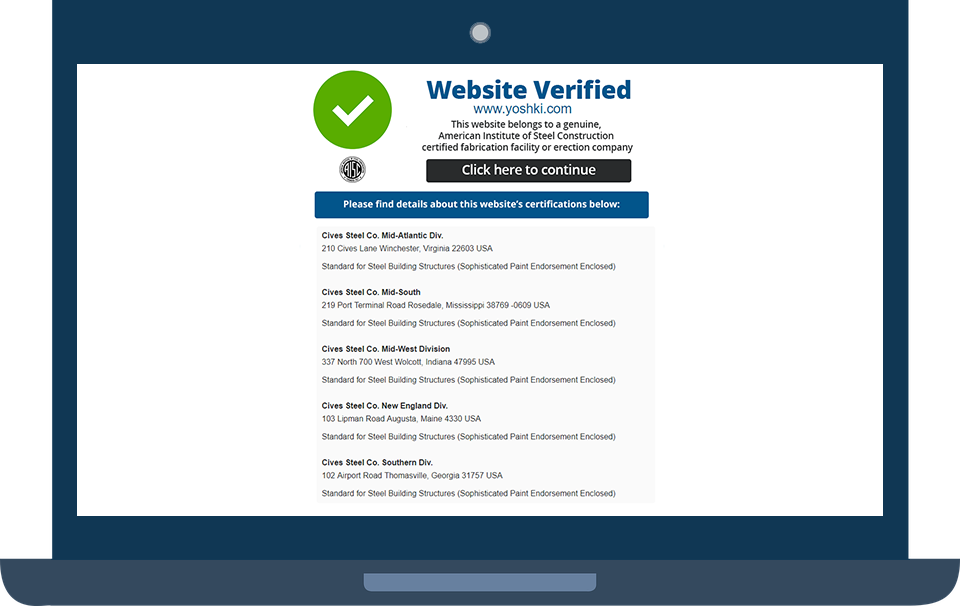
It's important that participants begin using these new logos as soon as possible. Beginning in March, AISC will promote both the new logos and the "smart logo" verification system to specifiers. They will be told that unless a participant is using the new logo and verification system, they should check directly with AISC.
If you would like to read more about our new smart logos, check out this article from the March 2019 edition of Modern Steel Construction!
Bulletin 2019-01: Erector Audit Confirmations
Bulletin 2019-01: Erector Audit Confirmations notifies erector participants that AISC will not be requesting them to formally acknowledge receipt of the audit date notification email or submit project listings for the site audit. The Quality Management Company (QMC) auditor will request project listings when they email their audit plan (roughly 30-45 days before the audit date).
Certification Resources
Looking for a handy tool to help streamline your quality management system? This Certification Resources site contains a range of resources to help you do just that. From a non-conformance worksheet to sample internal audit forms, these tools will simplify your daily tasks and improve your overall quality.
In January 2019, AISC updated the Guide to Normative and Informative References for AISC Certification Programs. The guide identifies all the required normative and beneficial, informative references for every certification program and endorsement. Be sure to check out this updated resource!
Updated Certificates
AISC Certification has updated the appearance of our certificates to reflect AISC's new brand and tagline: Smarter. Stronger. Steel. The certificate is cleaner and easier to read, so be on the lookout for this updated design.
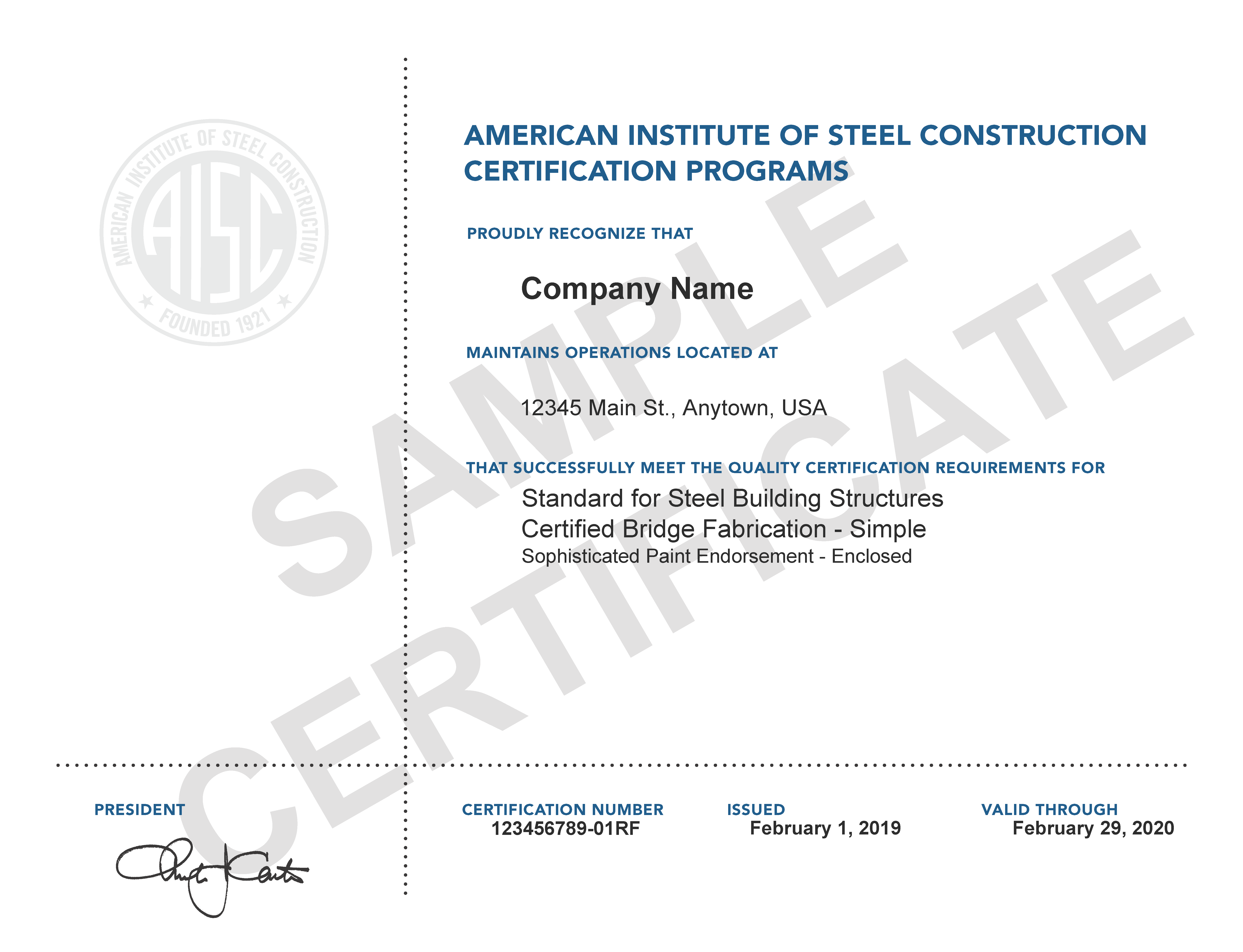
Newsletter 2018-Q3
Mark's Remarks: Advance the Structural Steel Industry through Certification, Auditing and Education
Welcome to the 2018 Third Quarter AISC Certification Newsletter!  In this and future newsletters, we will provide news and information with a focus on how you can get the most value from your investment in AISC Certification.
In this and future newsletters, we will provide news and information with a focus on how you can get the most value from your investment in AISC Certification.
This issue includes an article by QMC’s director, Larry Martof, on welding equipment calibration, along with some exciting news about the expanded quality track at NASCC: The Steel Conference. Plus, don’t miss the new audit tools and resources available to help streamline your day-to-day operations.
As a reminder, here are AISC Certification’s 2018 Goals:
- Become a more participant-responsive program
- Conduct a comprehensive and rigorous audit, providing recognized value to the participant and the construction marketplace
- Advance the structural steel industry through certification, auditing and education
Having introduced goals one and two in our previous newsletters, this edition will focus on goal three.
A long time ago while still in elementary school, I "learned to learn" by listening to and watching my teacher demonstrate problem-solving techniques. Though not fully understanding what I had seen, I would emulate my teacher and try to solve the problem her way. I would continue solving problem after problem until the problem-solving steps were second nature and became a permanent tool in my tool belt. Then, a new type of problem would be introduced, and the cycle of learning would continue.
But these days, being much older and more experienced, I have carelessly forgotten the benefit of following this tried and true problem-solving process. More to the point, I can convince myself that my life experiences alone have prepared me to solve any problem put in front of me – which is a big mistake! Without teachers, learning takes much longer, and life is too short to rely on our own knowledge.
Coming to AISC from the structural steel fabrication side of our industry, I served as the AISC Certification management representative for my employer, an AISC-certified fabricator. And what I say next comes from that experience. It is common for a company’s certification journey to begin much like my elementary school experience. Sometimes, there are the overwhelming tasks of developing and integrating a quality management system into the company’s culture – and companies often need outside help with this. Then there’s surviving the initial AISC audit. After this, you and your fellow employees become comfortable and confident with your processes and procedures – until the next audit, of course, when you realize that there’s more to learn!
An audit serves several purposes, and one of the most important is being exposed to the knowledge and experience of your auditor. I love to tell the story about how I learned that a W8x31 beam is not the same as a W8x31 column. Huh? During our initial audit, one of my favorite QMC auditors, Pat Thomashefsky, discovered that I was ordering column material incorrectly. She referred to ASTM A6, which requires column shapes to be identified as columns in order to meet tolerance requirements. I was oblivious to this requirement and, rather childishly, debated the point with her – until she showed me every line and verse of ASTM A6, 4.1.14 and Table 24. (Sometimes, learning can be frustrating and humbling.)
Don’t assume that because you are older and wiser, you should be the teacher. Discover the teachers around you, and don’t forget about your auditor. And keep on learning!
As always, let me know if we are providing value for your certification investment!
Until next quarter...
“Almost all quality improvement comes via simplification of design, manufacturing... layout, processes, and procedures.” Tom Peters
Mark W. Trimble, PE
Vice President of Certification
trimble@aisc.org
312.670.5436 (Office)
312.720.0131 (Cell)
Calibration: Don’t Forget About Your Welding Machine
By Art Bustos, AISC Program Analyst, and Larry Martof, Director of Quality Management Company
There has been a lot of talk recently about “calibration” of welding machines. As a matter of fact, the American Welding Society’s (AWS) forums are filled with discussions on this topic. The funny thing is, calibration is not an AWS requirement—so why do the AISC Certification programs require welding machines to be calibrated? To answer this, let's first explore quality management.
A quality management system (QMS) is a set of processes designed to provide reliability, consistency and quality to structural steel fabrication and erection. In its essence, it combines quality control (QC) or inspection with quality assurance (QA) or process control. A strong QMS will recognize that both QC and QA are needed in order for a process to function practically and efficiently. The welding process fits very neatly into this structure. From the QC perspective, welds need inspection, since AWS requires that, at a minimum, all welds are visually inspected. Chapter N of the Specification for Structural Steel Buildings (AISC 360-15) requires the periodic monitoring of the welding process to ensure that the welding procedure specification (WPS) is being followed, which is another element of inspection.
As for the QA perspective, it is incorporated from the very beginning of welding. The process of creating the WPS is done to provide a level of “assurance” that the welds created using the WPS parameters will be of sufficient strength to meet the design loads. When a welding operator is qualified for this welding procedure, there is confidence or “assurance” that they can produce an acceptable weld using the procedure. Throughout the qualification of the procedure and the operator, there are inspections performed to confirm acceptability. As long as the qualified operator uses the qualified procedure and we perform the needed inspections, we have “assurance” that the welds produced are meeting their intent.
But there’s another important component when it comes to QA for a welding process: the welding machine. Without it, we have no welds. It provides the link between the operator and the weld—much like the welding lead connects the machine to the stinger. The operator relies on the welding machine to provide feedback that the WPS is being followed, which comes in the form of the machine’s meters. If the meters are not accurate, then the operator will not know if they have properly set their machine, and they will not have “assurance” that the welds will meet the strength needed. How do we provide the operator with this assurance? We calibrate the meters.
To reiterate, calibrating a welding machine is NOT an AWS requirement; it's a QMS requirement with QA at its core. Calibrating the machine meters provides the operator with an accurate starting point. When this is combined with the monitoring of the welding process to the WPS, we then have the means to provide “assurance” of the entire welding process.
Here’s how the calibration process works: The quality control inspector (QCI) calibrates the welding machine using a handheld meter that is calibrated and traceable to a national standard. Then, they monitor the welding by positioning the handheld meter as close to the welding gun as possible to see that the WPS parameters are being met. When long welding leads are being used, this monitoring could reveal that the welding machine output may need to be increased.
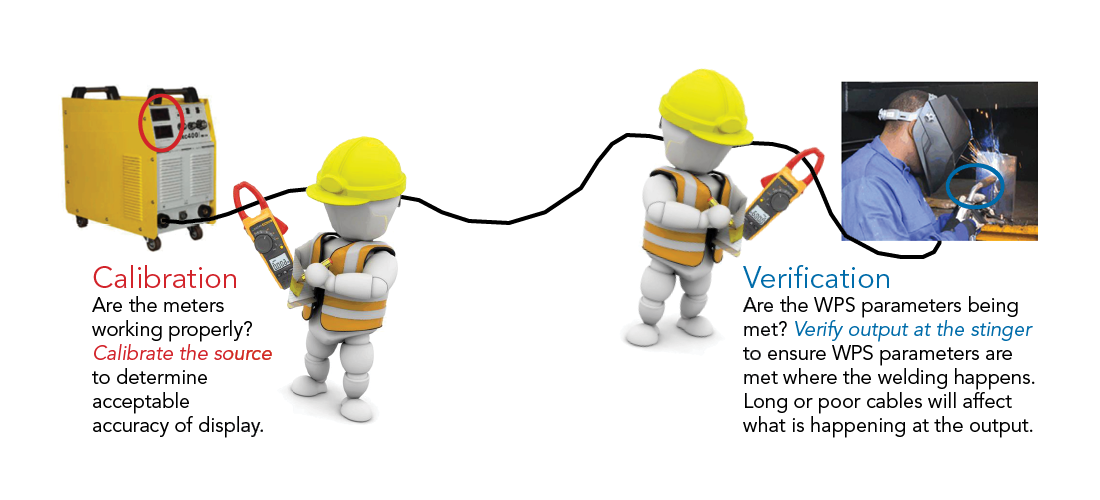
With this comparison being performed against the WPS, the operator can accurately adjust the machine—because they already know the meters are accurate, since they were calibrated. The QCI can then go on to other tasks, because they have assurance that the welding process is meeting all requirements, while the operator can continue to monitor their welding process accurately and produce acceptable welds.
Remember: The welding process is a combination of QA and QC functions. The QA functions of calibration and procedure qualification provide confidence in the welding, and the QC inspections complete the process for meeting the project requirements.
Audit Resources and Tools
Did you know we have a range of free audit resources and tools? They can help you prepare for your audit and are useful on a day-to-day basis to streamline your quality management system. In addition to being listed below, they are noted as dropdowns on each of the Applicants, Certified Fabricators, and Certified Erectors webpages.
- CAR Form Sample
- Corrective Action Request Procedure
- Guide to Normative and Informative References
- How to Write a Procedure
- Non-Conformance Worksheet
- Paint Inspection: Daily Coating Inspection Report
- Paint Inspection: DFT Measurement Worksheet
- Sample Calibration Record
- Sample Internal Audit Forms for AISC 207-16
- Sample Management Review Form for AISC 207-16
2018 NASCC's Quality Track
Miss the 2018 NASCC: The Steel Conference in Baltimore? AISC Certification just posted our 13 Quality Track sessions. Watch them now–for free!
What’s next for quality and the NASCC? We are already working on our next NASCC Quality Track, which will be held on April 3-5, 2019 in St. Louis. AND in 2020, we will be holding our very first World Steel Quality Conference in conjunction with NASCC. We will be providing two different paths for attendees: 1) fundamentals of quality management systems and 2) advanced quality topics, such as lean, six-sigma, quality statistical analysis, etc.
- Q1 - Certification is More than Just a Standard
- Q2 - The New Certification Program Requirements and Standard: What Do They Mean for You?
- Q3 - The New Certification Requirements and Standard: Additional Update for Bridge and Hydraulic Fabricators
- Q4 - The New Certification Requirements and Standard: Additional Update for Building Fabricators and Component Manufacturers
- Q5 - How do You, as a Manager, Drive Results?
- Q6 - Making Sense of Welding Procedures and Requirements: Common Welding Questions Answered
- Q7 - Forging Values: Transforming Companies from Good to Great
- Q8 - Understanding Erector Non-Conformances
- Q9 - Typical Corrective Action Requests for Erectors
- Q10 - Quality Control Inspector—What's Required?
- Q11 - How Does a Fabricator Perform Their Own Documentation Audit?
- Q12 - Bolt it Right the First Time: Teaching Quality is Easier than You Think
- Q13 - Typical Corrective Action Requests for Fabricators
Newsletter 2018-Q2
Mark’s Remarks: Providing Recognized Value by Conducting a Comprehensive and Rigorous Audit
Welcome to the 2018 Secon d Quarter AISC Certification Newsletter! Our newsletters are designed to provide news and information with a focus on how you can get the most value from your investment in certification.
d Quarter AISC Certification Newsletter! Our newsletters are designed to provide news and information with a focus on how you can get the most value from your investment in certification.
Topics in this issue include: “How do You, as a Manager, Drive Results?” by Chris Crosby, PE of Industrial Steel Construction — a preview of his upcoming Quality Track Session Q5 at the NASCC: The Steel Conference in Baltimore, April 11-13, 2018. Also, the final Program Requirements for Fabricator, Erector and Manufacturer Certifications are now available online, and you will learn more about their rollout at the Quality Track Sessions Q2-Q4.
In last quarter's newsletter, I shared that AISC Certification must continue to earn its reputation of providing recognizable value. To ensure that our focus is on providing value, we established three goals:
- Become a more participant-responsive program
- Conduct a comprehensive and rigorous audit, providing recognized value to the participant and the construction marketplace
- Advance the structural steel industry through certification, auditing, and education
In the previous newsletter, I elaborated on the first goal: Becoming a more participant- responsive program. The second goal: Conduct a comprehensive and rigorous audit, providing recognized value to the participant and the construction marketplace, is the foundation upon which value is built.
The basic idea: Not every company applying for certification will become certified and not all certified companies will remain certified.
...and that’s how it should be!
An audit consists of two parts (or stages) and reveals a company's readiness for certification. The Stage 1 Audit (documentation audit) and the Stage 2 Audit (site audit) are evaluation tools AISC Certification and Quality Management Company (QMC) use to measure the maturity of a company’s quality management system (QMS).
The path to certification varies greatly, company to company, as do company quality management system maturity levels. Some begin the journey toward certification without written procedures, and therefore, have a lot of work to do before applying. Others, much further along the journey, simply apply, submit their QMS documents and await the site audit. In either case, the demonstration of capability begins with an evaluation of documents and continues with the site audit.
To be effective for an evaluation of readiness, the audit must be comprehensive, rigorous, and require a company to demonstrate it has the personnel, organization, experience, procedures, knowledge, equipment, and commitment to provide quality products and services.
Let me know if we are providing value for your certification investment!
Until next Quarter...
“Quality is not an act, it is a habit.” Aristotle
Mark W. Trimble, PE
Vice President of Certification
trimble@aisc.org
312 670 5436 (Office)
312 720 0131 (Cell)
NASCC's Quality Track
Are you looking to learn more about quality? Look no further then the Quality Track at the NASCC: The Steel Conference!
The conference held in Baltimore, MD on April 11-13, 2018 is offering 13 sessions focusing on a range of topics to help increase your industry knowledge and will assist in strengthening your company’s quality management program. There will be targeted sessions for both fabricators and erectors, plus three sessions concentrating on the new certification standard and its future rollout: Certification Standard for Steel Fabrication and Erection, and Manufacturing of Metal Components (AISC 207-16).
For a complete list of 2018 topics, session descriptions, and times, please download the Quality Track Agenda.
For a list of all previous quality sessions, please visit NASCC Quality Track Sessions.
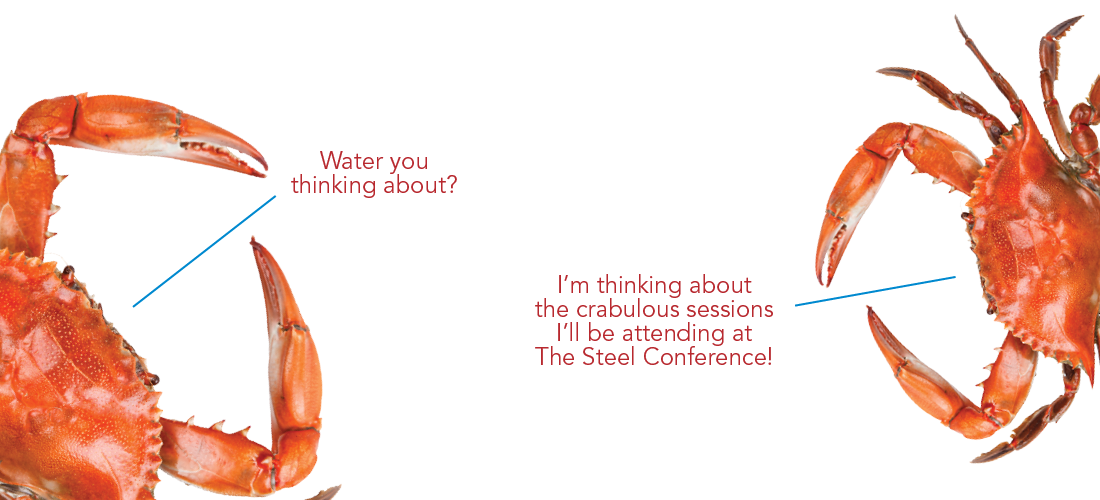
How Do You, as a Manager, Drive Results?
The below preview article is for Session Q5: How Do You, as a Manager, Drive Results?, which will be presented on Wednesday, April 11, 2018 at 5:30 p.m. at the NASCC: The Steel Conference. For a complete list of topics, session descriptions, and times, please see the Quality Track Agenda.
How Do You, as a Manager, Drive Results?
By Chris Crosby, Vice President Engineering, Training and Business Development, Industrial Steel Construction, Inc.
Several years ago, I was meeting with one of the members of the NASCC steering committee, discussing different topics for future classes. We were kicking around several different quality-related topics, and somehow we got sidetracked and started talking about general business problems not just related to quality. One topic we discussed for a long time was how successful managers drive results, and that begged the question: “As a business manager, how do I drive results?” We started down the typical path of carrot and the stick, yelling and screaming, money, promotions, additional responsibility and power, but then we started to look at the issue from a different perspective—the perspective of employees—people. Unfortunately, our time ran out, and we moved on without delving any deeper.
Several years passed and the topic arose again. This time I was discussing the question with a close, trusted colleague whom I consider one of the smartest people I know. We batted around the idea for some time before she asked me “What if we question the whole paradigm of being “results-driven”? What if we put employees first? What if results are just a by-product of great people policies?” We looked at Forbes’ list of Top 100 Companies to Work For, and what did we find? Basically, an overlapping Venn diagram of companies that produce great results. That is to say, companies that treat their employees well are largely the same companies that produce great results and are leaders in their respective markets. So, the question we left on the table was…do we have to put our employees’ needs at the center of our business model to succeed?
I thought for months about this meeting and our discussions. As fabricators, we are always stating that we are in the business of selling labor. But do we stop and think about where our livelihood comes from? Do we understand that it’s our employees who make it happen, and without them, we are not shipping fabricated steel out the door? I thought about all the fabricators I have worked for in the past. Some of these fab shops “got it” while others did not. The fabricators who “got it” understood the importance of their employees and their impact on the success of the organization. What separated these shops from the other ones who did not “get it”? Leadership. That was the difference. It wasn’t technology or the next best piece of fabricating equipment or the latest and greatest welding machine or a grinding disc that could last for days. It was leadership. Leadership at all levels.
I have had many mentors and bosses over the years, but one specific leader sprang to mind, and I thought about how he “handled” the employees (including me) to drive results for the organization. I remembered several specific encounters with him, but they all had the same common denominator. As I recall, we were struggling with a rash of quality issues and failing to meet budgets on labor. As can be expected, this leader, my supervisor, had several long meetings with me to “discuss” my plan on turning these events around. He used the word “inspire” several times as we talked about the employees. In the heat of the moment, this did not resonate with me. It wasn’t until years later, while working for a different fabrication company, that the lightbulb came on when I ran into a major disconnect between my supervisor and myself on how to lead employees. One specific dark and dreary day, I was contemplating my lot in life and asked myself what the major difference between the two supervisors was. I generated a laundry list of adjectives, but one word surfaced after days of thinking – inspiration. The first supervisor had not only inspired me but encouraged me to inspire other employees while the second supervisor did the opposite. The first supervisor inspired me to take ownership of my responsibilities, lead the assigned employees, problem solve, manage the assets, mind the store and inspire others. He did all of this without having to micro-manage me, yell at me, carrot and stick me, or manipulate me.
Fast forward several years as I started to write my treatise of leadership through the eyes of an average Joe. This series of events came to mind, so I studied them, wrote about them, read about other people’s experiences and thought some more, and this is what I came up with: A great leader inspires employees to action and does not demand employees to action. How did the positive mentors in my career drive results? By inspiring me. The common denominator was that their leadership styles inspired their employees, making them better as a result of their leadership. The true measure of these mentors, these leaders, was their ability to make employees better, to inspire them, and to have an impact on them that lasted even when the leader was absent. Leaders who can provide that kind of inspiration motivate their employees and managers to achieve great results. And I’ll talk more about how they do this in Baltimore. Hope to see you there…
Conversion for Certified Companies
Beginning June 1, 2018 (May 1 for applicants), certified companies will follow the new Program Requirements for Fabricator, Erector and Manufacturer Certifications. The new requirements will reference the new Standard for Steel Fabrication and Erection, and Manufacturing of Metal Components (AISC 207-16). To assist, we are providing three resources containing more information about the conversion and and tools to help you through the process. If you have conversion questions, don’t forget we’re available at conversion@aisc.org or 312.670.7520.
-
The final Program Requirements for Fabricator, Erector and Manufacturer Certifications are now available online.
-
Visit the Conversion for Certified Companies site. It's a one-stop-site for information and resources, such as the conversion timeline, the AISC 207-16 Audit Guide highlighting the changes between the new standard the previous ones, etc.
-
Read the article "Streamlined Certification" in the March issue of Modern Steel Construction. It outlines the new certification program conversion and what it means for all certified companies.
-
Attend the Quality Track Sessions Q2-Q4 at NASCC: The Steel Conference in Baltimore starting on April 11, 2018. These three sessions will offer insight to the rollout and what it means for all certified companies. PLUS, the sessions will be posted online eight weeks after the conference, and you can watch them for free!
New Certification Bulletins
We have released three Certification Bulletins since our last newsletter. Certification Bulletins help to communicate program changes that may affect you. Their purpose is to explain the change and why it is occurring, plus they provide clarity and program transparency. If you have any questions about these, please contact us at certification@aisc.org or 312.670.7520.
-
Participant Conversion Bulletin – outlines the conversion process for all participants and applicants to the new program requirements and standard
-
Audit Scope Bulletin – includes an updated list of audit scope nomenclature (i.e., changes to your audit number)
-
Fabricator Audit Confirmation Bulletin – identifies changes for confirming an upcoming fabricator audit
Newsletter 2018-Q1
Mark's Remarks: Being More Participant-Responsive
 Welcome to the 2018 First Quarter Issue of the AISC Certification Newsletter! In this, and future newsletters, we will provide news and information with a focus on how you can get the most value from your investment in certification.This issue includes “AISC Certification: More Than a Standard,” by Larry Martof, Director of Qualify Management Company — a preview of his upcoming Quality Track presentation at the NASCC: The Steel Conference in Baltimore, April 11-13, 2018. Also included, is the latest certification bulletin, “Bulletin 2018-01 for Scheduling Site Audits.”
Welcome to the 2018 First Quarter Issue of the AISC Certification Newsletter! In this, and future newsletters, we will provide news and information with a focus on how you can get the most value from your investment in certification.This issue includes “AISC Certification: More Than a Standard,” by Larry Martof, Director of Qualify Management Company — a preview of his upcoming Quality Track presentation at the NASCC: The Steel Conference in Baltimore, April 11-13, 2018. Also included, is the latest certification bulletin, “Bulletin 2018-01 for Scheduling Site Audits.”
Just a few days after joining the staff of AISC last May, I met with the certification department staff to share my expectations for the future of the certification program. Providing Recognizable Value was the theme of my presentation. “To be worthwhile,” I said, “the Certification Program must provide value to those who rely on it.” During that meeting, we reviewed how jurisdictions, agencies and specifiers rely on the program to set a basic level of quality for their projects. And how our participants — the fabricators, erectors, and component manufacturers rely on the program to improve their management systems, quality, and to differentiate themselves from their competition.
From that meeting, we developed some initial goals:
- Become a more participant-responsive program
- Conduct a comprehensive and rigorous audit, providing recognized value to the participant and the construction marketplace
- Advance the structural steel industry through certification, auditing, and education
My focus in this issue will be on our goal of “becoming a more participant-responsive program.”
Coming to AISC from the fabrication industry, my perspective is that of a certified participant. In addition to 25 years with an AISC-Certified fabricator, my experience includes engineering design and construction project management — where I learned to always add value through my work and never waste time or money. Adding value, reducing waste and improving efficiency are key principles behind our efforts to become more participant-responsive.
During my travels, I have appreciated hearing about your adventures on the path to better quality and your interactions with the Certification Department. You have expressed your commitment to our programs, their value, and the effort it took to earn the coveted certificate. Most of you shared positive stories about how we have treated you. A few, however, gave examples that made me cringe.
With increased acceptance of AISC Certification as the way to set a project’s expected level of quality, more specifiers are including the certification requirement in their documents — and more fabricators and erectors are becoming certified. To minimize the growing pains, we have added additional contract auditors and made improvements to the way audits are scheduled. And, though we have nearly 1,600 participants in the program, conduct about 35 audits each week, and correspond with our participants hundreds of times each month, “cringe-worthy” experiences are never acceptable!
My commitment to you: If you will share your certification experiences with me (good and bad), we will continue to improve our responsiveness and provide better value for your certification investment.
“Give them quality. That's the best kind of advertising” -Milton S. Hershey
Mark W. Trimble, PE
Vice President of Certification
trimble@aisc.org
312 670 5436 (Office)
312 720 0131 (Cell)
NASCC's Quality Track
Are you looking to learn more about quality? Look no further then the Quality Track at the NASCC: The Steel Conference!
The conference held in Baltimore, MD on April 11-13, 2018 is offering 13 sessions focusing on a range of topics to help increase your industry knowledge and will assist in strengthening your company’s quality management program. There will be targeted sessions for both fabricators and erectors, plus three sessions concentrating on the new certification standard and its future rollout: Certification Standard for Steel Fabrication and Erection, and Manufacturing of Metal Components (AISC 207-16).
For a complete list of 2018 topics, session descriptions, and times, please download the Quality Track Agenda.
For a list of all previous quality sessions, please visit NASCC Quality Track Sessions.

AISC Certification: More Than a Standard
The below preview article is for Session Q1: Certification is More than Just a Standard, which will be presented on Wednesday, April 11th, 2018 at 8:00 a.m. It kicks off the Quality Track at the NASCC: The Steel Conference. For a complete list of topics, session descriptions, and times, please download the Quality Track Agenda.
AISC Certification: More Than a Standard
By Larry Martof, Director of Quality Management Company
There is a misconception that the “standard” encompasses all of the requirements you must adhere to and be audited too. In reality, it is only one piece of the certification pyramid so, let’s explore this further.
The steel construction industry relies on many documents to drive quality and design. These cover both informative and normative references. Informative references provide good information that can be helpful to assist the user with a particular topic while normative references contain requirements that must be followed. Contract documents will identify the standards that must be followed, and normative may specify a particular version or just use the current edition. But there is no single document that encompasses the entire construction project. It is the same with certification programs; the standard is only one of many documents that provide the criteria to be followed. But there is a defined hierarchy to the many normative documents used in the AISC certification programs.
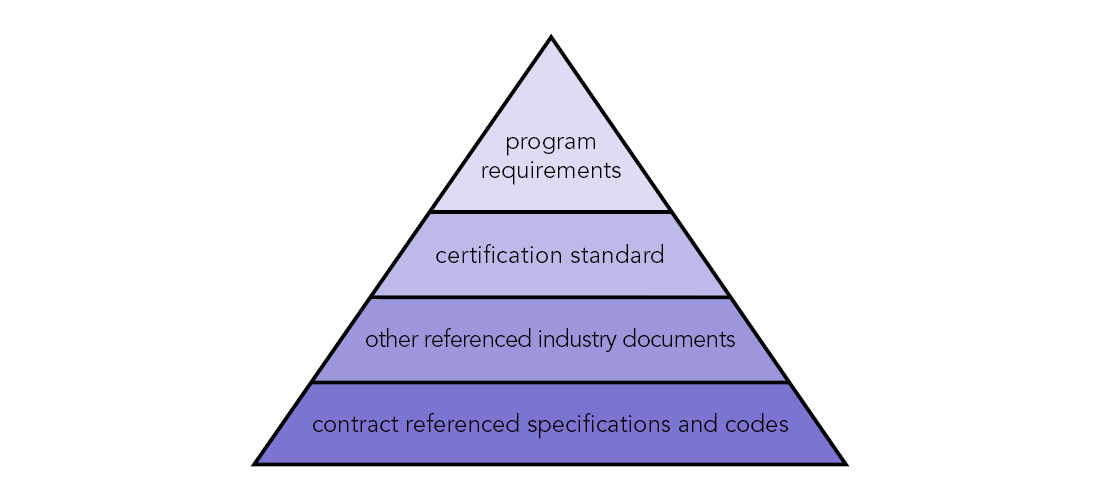
At the top of the document pyramid lays the program requirements. This document provides the administrative requirements for the execution of the certification program. They contain the process for application, scheduling, auditing, certification decision, appeals, and complaints. They also establish the other normative references used as requirements in the program. For example, the Certified Building Fabricator Program starts with the program requirements. These requirements state that the AISC Certification Program for Structural Steel Fabricators – Standard for Steel Building Structures, 2006 is used as a normative document and refers to it as the standard. So it becomes the second tier of our document pyramid. The standard goes on to references other industry normative documents such as the AISC Code of Standard Practice, AISC Steel Building Specification, AWS D1.1 Welding code and the RCSC Bolt Specification. It also identifies the contract documents as another set of project-specific normative documents. This completes our document pyramid.
Why is this important to an applicant or participant in an AISC certification program? Well, in each of the standards, we find a statement in Section 3 that states: “The Fabricator/Erector/Manufacturer shall have the latest editions available and be able to demonstrate the ability to work to and meet the requirements of:” which is followed by a list of reference documents. The “shall” in Section 3 makes this list of documents normative, so they are part of the requirements to be followed, met and used as audit criteria. As a helpful resource, there is a complete list of site references for all certification programs listed under the “Audit Resources” tab of the Applicants, Certified Fabricator, and Certified Erectors pages at www.aisc.org/certification.
AISC Certification begins with the program requirements. Program requirements have been issued for all of the certification programs, and either includes the endorsements or reference endorsement program requirements. In spring of 2018, AISC will announce a public review period for a new set of program requirements. This new set will harmonize the five current programs into a set of general program requirements which apply to all certifications and supplemental requirements that are specific to a certification program. The general set will include information from the application to receiving a certificate and all the steps in between. The intent is to have a more thorough and complete set of requirements so that each participant or applicant understands the process to be or become an AISC certificate holder. In today’s vernacular, AISC Certification must be “transparent” to our applicants and participants, specifiers, engineers, architects, jurisdictions, and customers who comprise the structural steel industry that we serve.
Bulletin 2018-01 for Scheduling Site Audits
The first bulletin for 2018 describes the AISC Certification scheduling process for site audits and includes the 2018 and 2019 Audit Schedules. The bulletin is available here.
The audit windows, defined in the bulletin and noted in the Audit Schedules, had their time-frames shifted. This shift allowed for more time between the site audit and certificate expiration (please note the certificate expiration month did not shift). Though beneficial for reasons listed in the bulletin, the shift resulted in frustration for some companies who experienced audit dates earlier than customary. For those companies who were negatively affected, we apologize.
To eliminate the frustration, we are publishing the audit schedules, which note the month an audit is expected to occur depending on a certificate’s expiration date. Participants will now know of their audit month well in advance to help assist in planning activities.
